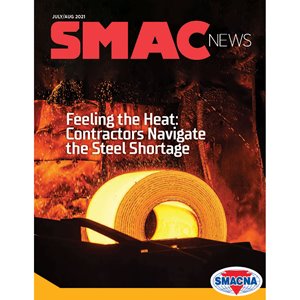The 6 Most Common Mistakes Estimating Teams Make — and How to Overcome Them
The estimation process is critical to the success of any given project, but it’s also a leading indicator of the overall health of your construction business in the long term.
 The estimation process is critical to the success of any given project, but it’s also a leading indicator of the overall health of your construction business in the long term. Research by Quickbooks found that 25% of construction companies are at risk of business closure because of inaccurate estimates, which demonstrates just how important it is to have well-defined estimation procedures. When your project estimates are on point, you can protect your profit margins, produce more competitive bids and ultimately win more work.
The estimation process is critical to the success of any given project, but it’s also a leading indicator of the overall health of your construction business in the long term. Research by Quickbooks found that 25% of construction companies are at risk of business closure because of inaccurate estimates, which demonstrates just how important it is to have well-defined estimation procedures. When your project estimates are on point, you can protect your profit margins, produce more competitive bids and ultimately win more work.
But there are a handful of issues that present roadblocks for estimators time and time again. Here are six of the most common pitfalls we’ve seen recently and, more importantly, innovative ways companies are navigating these challenges.
1. Working in a silo and not centralizing data
The takeoff and estimation processes are truly a team sport. Both involve multiple parties across various teams — many times across different companies — coming together to review proposals, plans, specifications and a host of other documents. With so much collaboration throughout the estimation process, having disjointed data and communication leads to confusion, errors and ultimately costly rework.
Unfortunately, too many estimating teams are working in silos and storing data in different locations, which leaves teams working from different documents and failing to stay updated with the latest project information. Working this way inhibits teams from knowing where the takeoff stands at any given point, leading to inaccurate estimates, increased rework and a negative experience for all involved.
To combat data silos and disjointed information, teams need to centralize all project data into one cloud-based platform. Having a single source of truth that gives all parties the most updated information produces more accurate estimates and keeps projects running smoothly when you get to the field.
2. Failure to create standardization across your company
There is often a massive lack of standardization when it comes to the takeoff process. When different scopes of work are performed — by different estimators working in silos (usually in desktop products) — there’s typically a lot of cleanup to be done to combine the quantities into one wholistic bid.
Estimating teams need to be standardizing for several reasons, including it helps ensure everyone is following the same naming structure; it allows the data to be easily consumed in downstream workflows; and it helps teams work much more efficiently overall. One approach to standardization is to employ templates across your organization. This helps streamline the process of creating takeoffs in a more efficient manner, so teams can focus on generating competitive bids rather than having to start projects from scratch.
3. Forgoing proper version control maintenance
As we all know, construction project details are hardly ever set in stone. When you don’t maintain or control the changes and versions created throughout the process, you risk giving team members outdated information, which results in incorrect estimates.
Once again, this pitfall becomes a nonissue when teams work from a centralized platform that always has the most updated project information. But another way to maintain tight version control is to use platforms that promote transparency and communication. When handling documents and data, use tools that add dates and time stamps so changes are automatically logged. Having a trackable record of revisions makes it abundantly clear who has worked on a task, what changes have been made and more.
4. Neglecting historical data (or not capturing data at all)
Historical project data is an essential part of estimation. It helps you compare your projects with similar past ones, ensuring your team operates with precision and efficiency rather than flying blind and reinventing the wheel with each new bid.
For example, with the recent lumber shortage and price increase, estimators could benefit by collecting and analyzing historical data of previous shortages and use those insights to build risks like this into their cost projections.
5. Not working in 2D + 3D
Leveraging 2D sheets and 3D models makes the estimation process much easier and presents a more wholistic vision of projects and estimation models. Utilizing both 2D and 3D quantification workflows lets teams leverage aggregated quantities from plans and models in an organized, customizable view.
Historically, takeoffs have been done in separate solutions where quantities must be combined manually later on in the process. Having 2D and 3D models coexisting in the same platform allows for better insight into project complexities and helps ensure that critical information is not lost or unaccounted for.
On top of that, working in 2D and 3D lets you create more visually appealing and compelling presentations to clients and executives, so you can give them an attractive and digestible depiction of your quantity takeoffs.
6. Resisting automation
Working with paper documents, clipboards and spreadsheets is a recipe for an inefficient estimation process. These manual practices not only take up time, they’re also highly prone to human error.
The right technology allows you to put various components of the estimation phase on autopilot — tasks like counting and calculating supplies and updating documents. By replacing manual tools and processes with software and automation, teams can be more productive and accurate with your estimates while freeing up time for higher-level jobs at the same time.
Are you making any of these mistakes in the estimation process?
The pitfalls discussed above are common in the industry; many estimators are still operating in silos and aren’t leveraging modern tools in their work. The good news is that overcoming these issues is completely achievable. By adopting a forward-thinking mindset and using the right technologies, construction professionals can take their estimates, projects and firms to the next level.
Published: September 3, 2021
IN THIS ISSUE
ARCHITECTURAL: Architecture Billing Index, A Key Indicator of Construction Spending
The COVID-19 pandemic threw the brakes on the economy in 2020, shuttering businesses around the world and throwing millions of people out of work.
Capitol Hill Update: Main St. Efficiency Act | Davis-Bacon | COVID Reimbursement | School Retrofits
SMACNA joined leading business and efficiency groups in supporting small business efficiency upgrade incentives that will be simplified with the Main Street Efficiency Act of 2021.
Cooking Up Clarity
Bringing guidance to food processing industry projects was goal of new SMACNA guidelines.
From the President: Guiding Resources
First it was the supply chain, then lumber prices, then steel…and now the COVID-19 Delta Variant is set to add a lot of uncertainty into the third and fourth quarters of this year.
How Leaders Can Build Enduring Resilience
We’ve all heard the phrase, “It’s a marathon, not a sprint.”
HVAC and Sheet Metal Companies Navigate Steel Shortage
For nearly two years, the Covid-19 pandemic has triggered shortages of consumer goods in unexpected places. There were runs on cleaning products and toilet paper in the early days. Sporting goods stores have seen their selection of bicycles and
HVAC: Top Southeast Pediatric Healthcare System Taps Three SMACNA Members for New Campus
The Southeast’s top pediatric hospital system, Children’s Health of Atlanta (CHOA), will soon have a new hospital campus that provides advanced care for kids.
INDUSTRIAL: Industrial Safety: TAB Contractor Recognized
Beginning work at a nuclear power plant last year — the first new reactor construction in the United States since the Three Mile Island accident in 1979 — SMACNA contractor Research Air Flo expected heightened safety requirements.
RESIDENTIAL: Google Ads are a Great Way for Contractors to Gain New Business
For many contractors, Google Ads is a complex landscape, but with a couple of tips and tricks to simplify the process, Google Ads can be a very effective tool to gain new customers in new ways.
The 6 Most Common Mistakes Estimating Teams Make — and How to Overcome Them
The estimation process is critical to the success of any given project, but it’s also a leading indicator of the overall health of your construction business in the long term.
Upgrading Your Pre-Qualification Process to Today’s Market Demands
The purpose of a prequalification process is to evaluate whether a contractor is qualified to bid on a specific construction project.
Welcome New SMACNA Members


